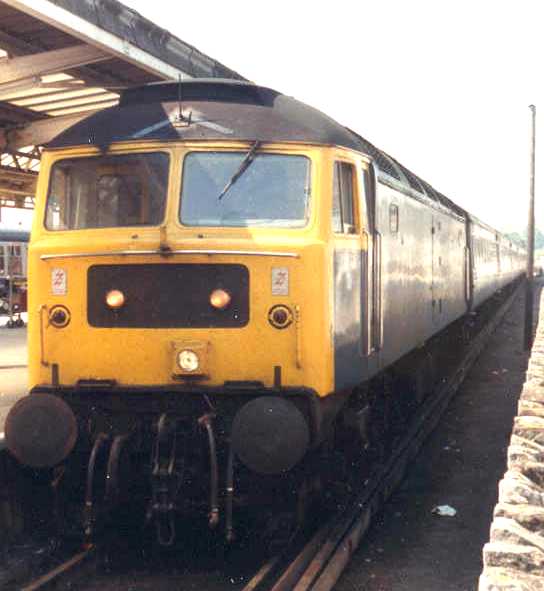- British Rail Class 48
Infobox Locomotive
name = Brush Type 4
British Rail Class 48
powertype = Diesel-electric
caption = Former Class 48, No.47117, at Weymouth station with a holiday passenger train in 1989.
roadnumber = D1702–D1706
totalproduction = 5
builder =Brush Traction , Falcon Works
builddate = 1965–1966
primemover = Sulzer 12LVA24
generator =
tractionmotors =
whytetype = Co-Co
uicclass = Co'Co'
wheeldiameter = convert|3|ft|9|in|m|3|abbr=on
minimumcurve =
trainbrakes = Vacuum
locobrakeforce = convert|60|LTf|kN|sigfig=3|abbr=on|lk=on
wheelbase = convert|51|ft|6|in|m|2|abbr=on
length = convert|63|ft|6|in|m|2|abbr=on
width = convert|8|ft|10|in|m|2|abbr=on
height = convert|12|ft|9+3/8|in|m|2|abbr=on
weight = convert|112|LT|t|sigfig=3|lk=on
topspeed = convert|95|mph|abbr=on|lk=on
poweroutput = "Engine:" convert|2650|bhp|0|abbr=on|lk=on
tractiveeffort =
fuelcapacity =
trainheating = Steam generator
multipleworking = Not fitted
axleloadclass =Route availability 7 (RA 6 from 1969)
railroad =British Rail
disposition = Re-engined to Class 47, 1969–1971__NOTOC__TheBritish Rail Class 48 was a diesel locomotive class which consisted of five examples, built at Brush Falcon Works inLoughborough and delivered between September 1965 and July 1966 [http://www.derbysulzers.com/engineer.html Engineer's notes] Derbysulzers.com - Retrieved on2007-11-25 ] . They were part of theBritish Rail Class 47 order, but differed from their classmates by being fitted with a Sulzer V12 12LVA24 power unit producing convert|2650|bhp|abbr=on|lk=in|0, as opposed to the standard 12LDA28 double straight-six unit of the remaining fleet.In service
The locomotives, numbered in the D1702-D1706 series, mainly worked from Tinsley depot in
Sheffield , on both passenger and freight work. In 1969, they moved toNorwich depot where they worked on express trains between there and London Liverpool Street. The 12LVA24 engine, however, was found to be unreliable, and the locomotives spent more time out of service than their standard counterparts. Engine failures were common, and repairs often expensive.Rebuilding
Eventually it was decided not to continue with the 12LVA24 experiment, and it was decided to remove the engines and fit the standard 12LDA28 engines to the locomotives. D1702 was the first to be so treated at
Crewe Works , using parts from D1908, withdrawn after a serious accident. It emerged in December 1969. All five locomotives had been so converted by early 1971, and then became standard Class 47s. The power units were sold toSNCF and used in their 68000 series locomotives.Further service & preservation
The locomotives continued in service for many years afterwards, and were renumbered 47114-47118 to conform with British Rail's
TOPS system in the early 1970s. Four of the locomotives were withdrawn from service between December 1990 and January 1991; the sole survivor, 47114, survived until 2002 when it too was sidelined. However, there was to be a further lease of life for 47117 (D1705) when it was bought for preservation by rail enthusiast and pop music producerPete Waterman . It is now owned by the Type 1 Locomotive Association and works on the private Great Central Railway [ [http://www.gcrailway.co.uk/locos/dd1705.htm D1705 at the GCR] - Retrieved on2007-11-25 ] . The other four locomotives have since been scrapped.References
External links
* [http://www.brushtype4.co.uk/bt4_zoom_v2x.php?
]
Wikimedia Foundation. 2010.
